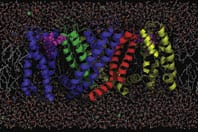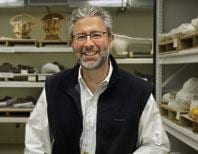Research and Discovery
White Dwarf Star Explodes in 3-D Simulation
A team led by Don Q. Lamb, Jr., Louis Block Professor in Astronomy & Astrophysics and Director of the Center for Astrophysical Thermonuclear Flashes, was the first to use supercomputer simulations to demonstrate how a white dwarf star explodes in three dimensions. Such explosions produce supernovas believed to be responsible for the production of iron in the universe and appear to be linked to the “dark energy” behind the accelerating expansion of the universe.
Temperament Linked to Tumors
Researchers at the Institute for Mind & Biology have identified striking links between behavior traits and tumor development and survival among rats. Apprehensive rats are more likely to die earlier from mammary and pituitary tumors than those with more adventuresome temperaments, perhaps due to hormonal disruptions. According to Martha K. McClintock, the David Lee Shillinglaw Distinguished Service Professor in Psychology, the findings have implications for research on cancer in humans.
Supercomputing Grant for Potassium Channel Study
A study directed by Benoit Roux, Professor in Biochemistry & Molecular Biology and the College, will employ massive computer simulations to understand the voltage gating of the potassium channel, which functions as a molecular switch controlling the flow of information and material through cell membranes. Four million hours of supercomputer processing time for the project were granted by the Department of Energy.
Study Reveals Complex Beliefs of Black Youth
The Black Youth Project surveyed nearly 1,600 black, white, and Hispanic youth nationwide to provide a comprehensive understanding of the perspectives of African Americans ages fifteen to twenty-five and how they differ from other groups. Cathy Cohen, the David and Mary Winton Green Professor in Political Science, launched the project to gather empirical data on young blacks’ views of social and cultural issues, government and politics, and sexual behavior and attitudes.
Chemists Predict Blood Clotting
Rustem Ismagilov, Associate Professor in Chemistry and the College, and a team of graduate students have employed microfluidics to develop the first simple laboratory model that can be used to predict when and where blood will clot. The model will enable scientists to understand the rules governing complex biological reaction networks such as clotting. The work earned Ismagilov the inaugural award for Early Excellence in the Field of Organic Chemistry from the Journal of Physical Organic Chemistry.
New View on French Renaissance Art and Society
Rebecca Zorach, Associate Professor in Art History and the College, won acclaim for her book Blood, Milk, Ink, Gold: Abundance and Excess in the French Renaissance, an interdisciplinary look at the visual culture of the French Renaissance which connects multiple art forms to the social, economic, and political forces of the period. The book won the Gustav O. Arlt Award from the Council of Graduate Schools and a best book prize from the Society for the Study of Early Modern Women.
Evidence of Early Urban Development Unearthed in Syria
Recent archeological excavation in northeastern Syria has revealed new details of the violent end of Hamoukar, one of the world’s first cities. The team, led by Clemens Reichel, Research Associate in the Oriental Institute, found evidence of both extensive industrial production and intense warfare, including 2,300 egg-shaped sling bullets and the remnants of devastating fires that destroyed the city in 3500 B.C.
Ultra-Cold Lab Explores Quantum Complexities
Believing that ultra-low and ultrahigh temperatures share common characteristics, Cheng Chin, Assistant Professor in Physics and the College, is using ultra-cold conditions to simulate the impossibly hot conditions that followed the big bang to determine how complex patterns emerge in atoms. Supported by a Packard Fellowship for Science and Engineering of $625,000 over five years, his experiments could also lead to new capabilities in quantum computing.
Neanderthal Genome Study Suggests Early Split with Humans
The most comprehensive study of the Neanderthal genome to date has led scientists to conclude that Neanderthals and humans share a common ancestry but show no evidence of genetic admixture, indicating a separate evolutionary path over the last 400,000 years. Co-author Jonathan Pritchard, Professor in Human Genetics and the College, led the Chicago team that analyzed the genetic sequencing data.
Evolutionary Theory of Limb Development Disproved
A long-held theory of evolutionary limb development was overturned by researchers in the laboratory of Neil H. Shubin, the Robert R. Bensley Professor in Organismal Biology & Anatomy and the College. Postdoctoral fellows Marcus David and Randall Dahn showed that the genetic ability to build limbs was already present in primitive fish long before animals with limbs appeared some 365 million years ago.
Unique Financial Mathematics Program Gains Support
The only research center in the nation, if not the world, devoted to financial mathematics received a naming gift of $7 million from Steve G. Stevanovich, AB’85, MBA’90, founder of an international asset management firm. The Stevanovich Center for Financial Mathematics, devoted to research using mathematics to understand increasingly complex financial markets, will increase contact between financial practitioners and University faculty members.
Law School Adds Immigrant Children’s Advocacy Project
Law School students serve as advocates for unaccompanied immigrant children through a program brought to the University by its founder, Maria Woltjen, a children’s rights lawyer and Lecturer in the Law School. The Edwin F. Mandel Legal Aid Clinic now houses the unique program, which provides legal assistance to undocumented children whose parents or guardians have been apprehended by immigration authorities.
New Properties of Magnetism Uncovered
Scientists at the University, Argonne National Laboratory, and the London Centre for Nanotechnology have employed an advanced form of X-ray spectroscopy to reveal the inner workings of antiferromagnets, such as the metal chromium, for the first time. The interior structure of antiferromagnets was previously too fine to be visualized. The breakthrough research could lead to new applications in emerging technologies, such as quantum computing.




